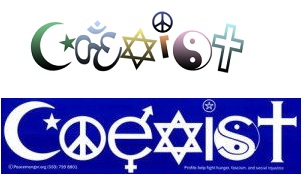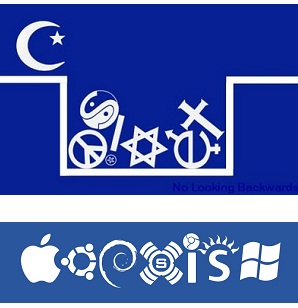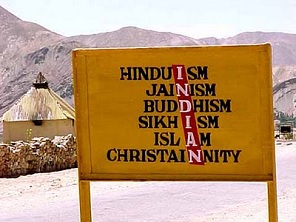A great many people will have seen (or designed) some variant of the “coexist” bumper-sticker / tee-shirt design:

— the first of which can be found on acsapple‘s photobucket — and hey, the “aum” sign for “oe” is a brilliant bit of graphic substitution! while I nabbed the second here.
What with a thousand flowers blooming, the importance of preserving memetic variations, peaceful coexistence and all, it’s only natural that some will have different takes on the matter —

— the first of these comes from the blog of a gun-toting political refugee from the People’s Progressive Republic of Massachusetts, while the second is a tee-shirt design by Matt Lussier, and you can get your tee-shirt here…
*
As for myself, I have fond memories of India, and was accordingly heartened to see this on an Indian Muslim site…

which is what set me thinking about “coexistence” graphics in the first place.
*
Did I ever tell you about the sign I saw over a shop in Delhi, advertising the sale of mythelated spirits?
I frequently feel just a tad mythelated myself.
That indian muslim included some mysterious [to me] “jainism”, but judaism is missing from his list, for some reason. And it’s not like there are no jews in India – 2008′ bombing of a synagogue in Mumbai or writings of Salman Rushdie tell otherwise.
I can only guess that muslims (wherever they are, erecting signs in india or setting on fire garbage containers in jerusalem) have selective idea of “coexistence”
The Indian Jewish community has never been very large, with the Bene Israel numbering just 35,000 at its peak in the 1950s. Yet Indian Jews have achieved distinction far beyond their numbers. A great many chose to make a career in the military under the Raj (British rule that ended with independence 60 years ago this week)–a phenomenon that, believe me, is certainly foreign to the Eastern European Jewish experience.
Indeed, the most well-known Indian Jew is an eminent soldier: Lt. Gen. J.F.R. Jacob, who commanded Indian forces in the invasion of East Pakistan in 1971. Other Indian Jews achieved distinction in Bollywood, such as the pioneering actress Sulochana, queen of the Indian silent movies. It would probably surprise most Seinfeld fans to learn that Brian George, who played the sad-sack Pakistani restaurant owner Babu Bhatt, is an Israeli of Indian descent.
http://www.forbes.com/2007/08/05/india-jews-antisemitism-oped-cx_gw_0813jews.html
There are far, far fewer Jews than Jains in India, and Jainism has had an outsized impact on the larger culture than numbers might suggest.
I thought the sign was BEAUTIFUL.
I imagine it has a particular meaning within a large democracy containing many faiths – and, sadly, a history of communal bloodshed. It speaks to the efforts at creating a larger secular whole. We should not ignore this.
– Madhu
I thought the sign was BEAUTIFUL.
I am sure you would.
: )
– Madhu
(Can’t rile me. I’m too happy for that.)
Hi Tatyana, Madhu…
I have a response to Tatyana’s comment in the works, but since it contains a host of URLs, Jonathan needs to approve it…
Madhu, a pleasure to read you.
As written on the sign, “Christainity” looks like an amalgam of Christianity and Tai Chi which, while not quite polar, are sufficiently soft-hard opposing to be philosophically consonant with the idea of spiritual and martial fusion within Tai Chi.
Also, “coexistence” is one way to lump, to varying degree disparate, elements into a set and yin/ yang another that would bind the inherent contrasts and tension into a whole, which is Tai Chi, too.
Here’s an opposing pair of perspectives on the idea of the sign: The words are arranged to enable a common word to emerge from their letters, which seems to subsume the religions by the dominant notion of “Indian” and makes them parts of a whole. But if you look at the sign as an implied Venn diagram (I love them!), the various set circles drawn to overlap every other one would describe an intersection of relatively small area in relation to the overall set sizes. IOW, is India comprised of or big enough to accomodate all the faiths, or do all these faiths only happen to have a little geography and history in common?
Happy Hanukkah, everyone!
[Revision: a Venn intersection doesn’t have to be all that small, and I missed the two N’s in “CHRISTAINNITY.” What could possibly be the metaphysical implications of the redundanncy?]
Jane:
You’re right on the mark: the site itself is called “TwoCircles” and its About page features a quote from one Maulana Muhammad Ali Jauhar that says “I belong to two circles of equal size, but which are not concentric. One is India, and the other is the Muslim world.”
Their logo is a crescent — which is both an Islamic glyph, and formed of two circles showing considerable overlap…
Hi Tatyana:
The sign was posted on the net by an Indian Muslim site, but I don’t know that it’s a Muslim sign. Hinduism, Jainism, Buddhism and Sikhism are the four major religions that originated on the Indian subcontinent, just as Judaism, Christianity and Islam are the three major Abrahamic religions, see for instance Wikipedia on Indian Religions, and their Jainism entry for details of this ancient faith with its emphasis on non-violence. Islam and Christianity would be the two great religions introduced to the sub-continent by conquest, so the list as a whole makes sense to me, and I strongly doubt that Judaism was excluded by reason of prejudice. Besides, an “N” was needed at that point in the word “INDIAN” — and “Judaism” doesn’t have one.
The page on the Indian Muslim blog that that image comes from says quite clearly that they are opposed to those who might wish to cause divisions among their fellow Indians “in the name of religion, caste, region and language” and that “Those elements need to be indentified and isolated” — and contains a pretty impressive list of links to recent illustrations of inter-religious tolerance in India, including:
In India, it’s Ayodhya rather than Jerusalem that’s the contested holy place, and Hinduism and Islam the two religions who have coexisted pretty amicably for centuries, but whose respective extremists would like to (and sometimes do) stir up sectarian trouble.
Happy:
Hinduism
Atheism
Paganism
Protestantism
Yin-Yangism
So much meaning! Humble me can’t even comprehend the deep, deep thoughts of the Wise Men (and some older maternal-like women here..as long as they display appropriate deference to men) Oh, I so ramble sometimes!
“older maternal-like women here” “appropriate deference to men”?
Tis the season for Badwill on Gaia, apparently.
Charles, thanks for that math as meaning visual. Looks as if India is within the crescent of Islam (and almost wholly, ah holy?) I suppose other religions could be incorporated into or glom onto that representation and the crescent remain uncorrupted, if they are rendered as smaller faith-sets contained within India, perhaps destined to be nullified (from the Islamist viewpoint.)
In India, the peaceful coexistence of hundreds of millions of people of different faiths is the real story.
The refusal of any but a small minority of any group in India to take a path of violence is a source of hope. The original founding in 1947 was based on constitutional principles of religious tolerance and freedom. So far, that commitment has held good.
The Pakistani regime and the terrorists it supports wants nothing more than for sectarian warfare to break out in India. The Mumbai attacks were supposed to provoke an anti-Muslim backlash in India. it did not happen.And the vile people in the Pakistani regime will happily sacrifice any number of Muslim lives to try to provoke that conflict. So far the Indians of all faiths have refused to take the bait.
I’d like to thank Jonathan for taking care of my URL-heavy comment in response to Tatyana up above.
We all know there are terrorists who, under color of Islam, viciously attacked Hindus, Jews and tourists in Mumbai — and perhaps also that the tearing down of the Babri mosque in Ayodhya led to sectarian rioting in Gujarat in which almost 800 Muslims and a little over 250 Hindus died… but I think anyone who reads a few of the stories I linked to above — “Muslims help in construction of a Hindu temple in UP”, “Hindus raise money for Muslim girl’s wedding”, “Iftar at a Hindu temple in communally sensitive Krishnapura”, “19-yr-old Imran sacrificed his life to save two Hindu boys”, “A Muslim couple carve Hindu deities out of wheat stalks” and so on — can hardly fail to grasp that many, many members of the two faiths can and indeed do live amicably together – and lack the intense intolerance that can be seen among the more extreme members of their respective faiths…
This is one of those situations where one straight jacket does not fit all.
Badwill on Gaia
Such party poopers, I agree! Everyone who doesn’t share my overflowing phony happiness is Bad, Bad, and full of Badwill! And they try to rile me by writing 3 lines to my 30! They must be Gaia worshippers…or worse: Not Happy! That response was decidedly NOT tour de force. But it is of low importance anyway, as I always have more important things to do than write here. I’m busy!
Charles Cameron,
I appreciate your effort of educating me, especially explaining the origins of religions, and counting the major ones and even providing links – so many links! Links that prove nothing at all.
That famous tolerance and coexistence of India is nothing but a pretty Western myth, a hippie’ tale, a story for a yoga charlatan. There have been religious wars, and bloodshed unthinkable, and unimaginable brutalities, and sacrifices, and carefully drawn borders, as a result of that thousand-years-old strife: borders between religious groups, borders between casts, between professions, between cities and countryside, borders of internal censorship. Acts of kindness are, too, results of that 1000-old struggle: it’s a way of self-preservation in a dangerous environment. Tolerance there is not the same as in Western society: there is no freedom of expression granted equally to everyone; rather there are millions of eyes jealously guarding prescribed borders – and giving grief to anyone bold enough to cross.
India (and more so Pakistan, ShriLanka, Bangladash (sorry for possible bad spelling)) remain deeply backward countries, full of ancient superstition, astoundingly bad work ethics and professional knowledge (ask any American computer programmer who had a misfortune to work with Indian ones), system of clans, nepotism and dual monster of oriental flattery to the Powerful/contempt to subordinates.
Peace and coexistence, right.
oh, and on the subject of Indian muslims being for some reason different from all others, in terms of danger to all non-muslims: it’s from the same operatic aria as mythical “moderate” muslims.
I heard this before, and it’s beyond ridiculous.
Same have been said about muslims of Central Asia, Azerbaijan, Bosnia, etc.
Muslims are muslims. Those who hold Koran as their guiding book, can not by definition be “moderate”. They sleep under the radar, sometimes for decades, and then to the astonishment to their neighbors – here comes the educated, rich, successful assimilated muslim, raping and killing and cutting throats around him, for the glory of Allah.
Ask anyone who had to run from massacres in Armenia, in Tajikistan, in Abhazia. I lived in Tatarstan, and I know. I live in Bay Ridge (or BayRut, as local arabs call it in their wishful thinking), and I know. I have visited MI, and I know what happened to Dearborn.
Well, profound ethnic and religious (non-)coexistence aside, I think including both Ubuntu and Debian in the same sign is a bit of a cheat.
Chuck:
Ubuntu? Chthulu! — with another hat-tip to Erik Davis.
As a general rule, I dislike being preached at by bumper stickers. Most of us are perfectly happy to coexist, and have done so for years. But when the other guy is flying planes into buildings and bombing pizzerias all talk of coexistence goes out the window. And being castigated for my supposed intolerance is, well intolerable.
It’s also a lie. We Americans didn’t go around lynching Muslims after 9/11–media reports of the attack on a beturbanned Sikh or two notwithstanding. So just who are you preaching tolerance to, buddy?
That said, I liked the Indian sign insofar as I like anything of that sort. As a Jew, I wasn’t offended by the absence of Judaism on the sign. Yes, there are Jews in India, there have been for quite some time, but the percentage of Jews compared to the overall population is pretty negligible. Which is not to say that I believe the relative absence of anti-Semitism in India (as referred to in the Forbes article) is a sign that India is a wondrous magical place where such hatreds could never find a purchase. No, I think Indians have been too busy killing Jains, Hindus, Muslims and Sikhs to notice the relatively few Jews in their midst. There have been Jews in China for a long time, too. But the Chinese have been too busy with the Tibetans, Uyghurs, and the Falun Gong to pay them much mind.
The difference between India and China is that the Chinese have made repression and persecution a state policy while the Indians–Muslim, Hindu or others–have been free agents (with help from Pakistan for those on the Muslim side of the equation), as it were. A very important distinction.
No, I think Indians have been too busy killing Jains, Hindus, Muslims and Sikhs to notice the relatively few Jews in their midst.
Well, that’s the reason I liked the sign. Given the history of communal bloodshed, a lot of work and thought has gone into how to stop that sort of thing – in certain quarters anyway. Lex is right that the backlash predicted by Mumbai didn’t happen. The authorities learned from Gujurat. Long way away from perfection but moving in the right direction.
I suppose the problem with bumper stickers is that people see what they want to see. Being a child of Indian immigrants – and worried about attempts at radicalizing certaian populations here and in India – I saw an attempt at peaceful resistence to such radicalization.
Others saw something different.
Interesting.
As always, the CB commenters bring their best!
– Madhu
Rachel,
your version (that Indians were too busy killing all other groups to notice small sprinkling of Jews in their midst) might also work as explanation. Although, judging by the Rushdie’s novel, Jews are not only not invisible in India, but envied and used as scapegoats to hang all perceived evils on. In that regard wonderful fairy-tale India does not differ from everywhere else.
The novel is worth reading – if only to see that in every joke (or a fantastic tale…) there is only part of a joke.
Pondering the various comments on this post, I found my thoughts taking an abstract turn. A draft of what’s on my mind lately distills my current perspective on many of the topics I monitor, and responds to some of what has been written here.
I’d like to say again that intelligent strategy requires nuanced understanding.
You missed this one:
COEXIST Explained